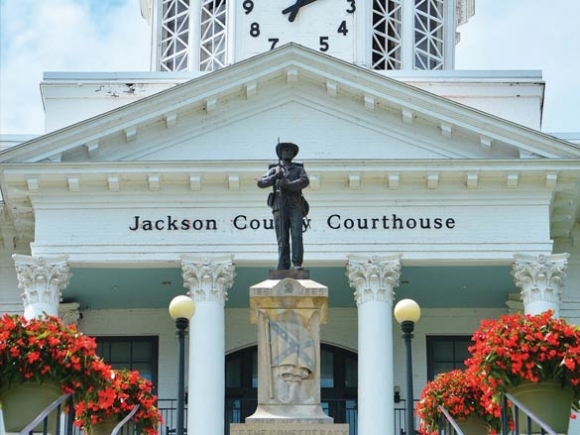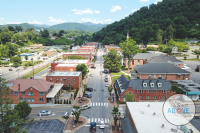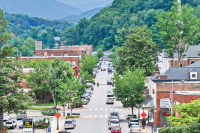Sylva statue draws debate

Ever since an August protest over removal of a Robert E. Lee statue in Charlottesville, Virginia, turned violent, a nationwide debate has erupted over the part Confederate monuments play in glorifying racism and treason — and the metal-cast Confederate solider standing guard over downtown Sylva is no exception.
In recent weeks, both the Sylva and Jackson County boards of commissioners have discussed the issue, while also knowing that a 2015 state law leaves local government bodies with no authority to remove the statue even if they wanted to. And, while few local leaders seem to actively endorse removing the statue, many seem to recognize the complexity and emotional weight of the issue.
“We’re going to make some decisions on health departments and stuff like that, but that ain’t a tough decision,” Jackson County Commissioner Boyce Deitz said during an Aug. 28 meeting. “This is a tough decision. This is a decision when you make it, people look at it and say, ‘That’s what he is.’”
Comments from county commissioners
Chairman Brian McMahan was the one who brought up the issue, departing from the board’s standard meeting format to begin by asking County Attorney Heather Baker to give an overview of the state law’s restrictions on monument removal and then following up with a 700-word statement he’d prepared to express his feelings on the matter.
“In light of what has taken place in our nation over the course of the last month, I would like to first take this opportunity to condemn in the strongest and harshest of ways any act of racism, bigotry, violence and hatred,” McMahan said. “What took place in Charlottesville, Virginia was hateful, immoral, egregious and just plain wrong. Any action by these white supremacist groups is a total embarrassment to this nation and they in no way represent my values or the values of most Americans.”
Related Items
McMahan went on to say that his grandfather, who stormed the beaches of Normandy on D-Day and endured a “living hell” as a Nazi prisoner of war, would be mortified to see Americans waving the Nazi flag. Similarly, McMahan said, there is no reason that the flag of the failed Confederate rebellion should be flown on any governmental property. However, he believes the statue depicting an unnamed Confederate solider should remain at its post on the steps to the Jackson County Public Library.
“Our statue represents the common soldiers who left the mountains of Jackson County to go and fight in a war that they may not have even supported,” McMahan said. “Our statue is a visual reminder of a period in our history, as unpleasant as it may have been. For all the talk about when the statue was erected, during the Jim Crow period, that too stands as a reminder of who we were, but not necessarily who we are today.”
McMahan said that he was “very disappointed” in the mob that tore down a Confederate monument in Durham on Aug. 14 and in vandalism to a sign for Jackson Paper, which included a likeness of Andrew Jackson, pointing out that many “powerful leaders of change” such as Martin Luther King, Jr. and Gandhi relied on nonviolent protest.
“Taking the statue down does not remove the hate that is in people’s hearts. That is our job … I pledge my full support of any effort to promote peace and harmony within our community, to ensure that the correct history is taught to younger generations, to visibly demonstrate what it means to love your neighbor and to honor and respect others around us,” he concluded.
Commissioners Mickey Luker, Ron Mau and Charles Elders all said they wholeheartedly agreed with what McMahan had to say.
“History’s history and we can’t change it, but we can make a difference moving forward every day,” Luker said, thanking McMahan for his comments.
Deitz’ comments, meanwhile, reflected his unresolved struggle over the statue’s true meaning and how to reconcile all the different pieces of history behind it. On the one hand, he said, his great-grandfather fought in the Civil War — a poor mountain-dweller who “didn’t have but one slave and that was him,” and who may or may not have even known what he was fighting for. But he can remember flipping through a book of World War II veterans put out at the time and seeing how the black veterans were pictured in the back of the book, whites in the front. He can remember the integration of Sylva-Webster High School in 1964 and the racist trappings of the era.
“We have some great (black) families in this community,” he said. “I’d hate to know they was passing something every day that made them feel like they was less.”
Deitz urged those listening to make an effort to understand the point of view of those who think differently from them.
“I never did have a debate class, but I think sometimes in debate they ask you to take this side and then next time take that side,” Deitz said. “I think it would behoove all of us to sometimes take the other side and see if you can understand what the other person’s thinking.”
Four people gave public comment on the issue that day, none of whom advocated for the statue’s removal. However, multiple people suggested that perhaps the problem wasn’t the monument’s existence — perhaps the problem was the display’s one-sided nature.
“Maybe one of the problems we suffer here in the South is we have a preponderance of monuments and remembrances to the Civil War and the Confederacy,” said Jane Koenig, of Teckasegee.
Talk in town hall
A few days earlier, the town of Sylva had had its own discussion about the statue — or, rather, a discussion about whether it would be worth having a discussion. The statue is a prominent part of the downtown Sylva landscape, but it’s on county property with state law preventing any decision for removal at the moment.
However, Commissioner Greg McPherson brought up the topic with the idea that, should something change, it would be a good idea for the town board to have a unified statement on the matter.
“Yes, it’s on county land, but it looms over Sylva and it is a prominent place in our downtown, so I think it would be wise to at least be a part of that discussion,” agreed Commissioner David Nestler.
“The more you talk about it, the more it will rouse up the public in my opinion,” said Commissioner Harold Hensley. “If it stays, it stays. If it goes, it won’t be the death of the town.”
“I would argue it would be better for the town,” McPherson said.
While both McPherson and Nestler agreed that removing the statue would be the best course of action and that the board should discuss the matter, none of the other board members joined their request that the topic be placed on the agenda.
“I just want to wait and see how this is going to unfold before I have anything to say about it,” said Commissioner Barbara Hamilton.
“We definitely don’t want it to be a kneejerk reaction,” agreed McPherson.
However, in a follow-up interview McPherson was adamant in his view that the statue should go, calling it “a symbol of hatred.” While he acknowledges the value of lives lost on both sides of the Civil War, he pointed out there was at least one regiment of Union soldiers from Western North Carolina and that Sylva’s statue wasn’t erected until 1915, 50 years after the Civil War had ended and at the height of the Jim Crow era.
“For me, it just comes down to history,” McPherson said. “There’s a spike in Confederate monument building 50 years after the civil war, and there’s another one 100 years after the Civil War. It’s a direct response to Jim Crow and it’s a direct response to civil rights in my eyes. It’s an assertion of white power.”
Response from the NAACP
Enrique Gomez, president of the Jackson County chapter of the NAACP, said that he appreciated what McMahan had to say on the issue but also agrees with McPherson’s stance that the historical context of the statue’s erection makes it a symbol of something more than fallen brothers, fathers and sons.
“The ideological underpinnings under (the Confederate States of America) was about creating a racial order that addressed not just the separation of but the dominance of people of European descent over people of African descent,” Gomez said.
Before it was a library, the building where the statue stands was the county courthouse. How must it have felt, Gomez asked, for a black person walking into the courthouse seeking justice to pass by a statue symbolizing the Confederacy’s view of him as a lesser being?
“My position is this, and that is that if we are going to have a monument in a public space, that monument must absolutely reflect our deepest constitutional and moral values that hold us together as a community,” he said. “As it is right now, it is difficult for me to recognize how that image in front of us speaks to our deepest constitutional and moral values.”
However, Gomez continued, whatever happens to the statue should be a carefully thought-out decision, not an emotional reaction. If the decision is to remove it, he said, there should first be a plan as to what should go in its stead.
“Having an empty space is a problem to itself,” Gomez said. “If we are going to take some kind of action, we must be prepared to come up with a symbolic element that does speak to our deepest constitutional and moral values … The question is what should that symbol be? That can only emerge out of much deeper conversations, and that is going to require some time.”









